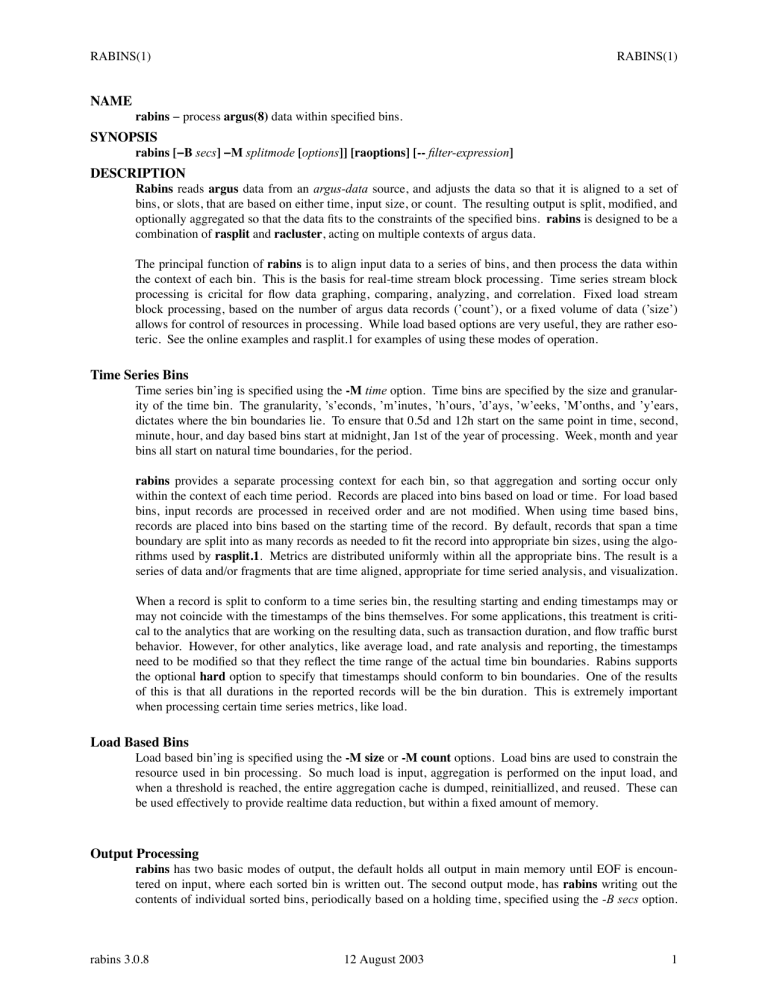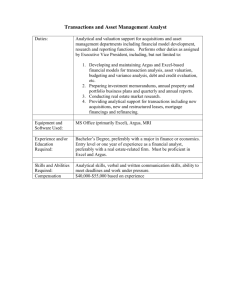
RABINS(1)
RABINS(1)
NAME
rabins − process argus(8) data within specified bins.
SYNOPSIS
rabins [−B secs] −M splitmode [options]] [raoptions] [-- filter-expression]
DESCRIPTION
Rabins reads argus data from an argus-data source, and adjusts the data so that it is aligned to a set of
bins, or slots, that are based on either time, input size, or count. The resulting output is split, modified, and
optionally aggregated so that the data fits to the constraints of the specified bins. rabins is designed to be a
combination of rasplit and racluster, acting on multiple contexts of argus data.
The principal function of rabins is to align input data to a series of bins, and then process the data within
the context of each bin. This is the basis for real-time stream block processing. Time series stream block
processing is cricital for flow data graphing, comparing, analyzing, and correlation. Fixed load stream
block processing, based on the number of argus data records (’count’), or a fixed volume of data (’size’)
allows for control of resources in processing. While load based options are very useful, they are rather esoteric. See the online examples and rasplit.1 for examples of using these modes of operation.
Time Series Bins
Time series bin’ing is specified using the -M time option. Time bins are specified by the size and granularity of the time bin. The granularity, ’s’econds, ’m’inutes, ’h’ours, ’d’ays, ’w’eeks, ’M’onths, and ’y’ears,
dictates where the bin boundaries lie. To ensure that 0.5d and 12h start on the same point in time, second,
minute, hour, and day based bins start at midnight, Jan 1st of the year of processing. Week, month and year
bins all start on natural time boundaries, for the period.
rabins provides a separate processing context for each bin, so that aggregation and sorting occur only
within the context of each time period. Records are placed into bins based on load or time. For load based
bins, input records are processed in received order and are not modified. When using time based bins,
records are placed into bins based on the starting time of the record. By default, records that span a time
boundary are split into as many records as needed to fit the record into appropriate bin sizes, using the algorithms used by rasplit.1. Metrics are distributed uniformly within all the appropriate bins. The result is a
series of data and/or fragments that are time aligned, appropriate for time seried analysis, and visualization.
When a record is split to conform to a time series bin, the resulting starting and ending timestamps may or
may not coincide with the timestamps of the bins themselves. For some applications, this treatment is critical to the analytics that are working on the resulting data, such as transaction duration, and flow traffic burst
behavior. However, for other analytics, like average load, and rate analysis and reporting, the timestamps
need to be modified so that they reflect the time range of the actual time bin boundaries. Rabins supports
the optional hard option to specify that timestamps should conform to bin boundaries. One of the results
of this is that all durations in the reported records will be the bin duration. This is extremely important
when processing certain time series metrics, like load.
Load Based Bins
Load based bin’ing is specified using the -M size or -M count options. Load bins are used to constrain the
resource used in bin processing. So much load is input, aggregation is performed on the input load, and
when a threshold is reached, the entire aggregation cache is dumped, reinitiallized, and reused. These can
be used effectively to provide realtime data reduction, but within a fixed amount of memory.
Output Processing
rabins has two basic modes of output, the default holds all output in main memory until EOF is encountered on input, where each sorted bin is written out. The second output mode, has rabins writing out the
contents of individual sorted bins, periodically based on a holding time, specified using the -B secs option.
rabins 3.0.8
12 August 2003
1
RABINS(1)
RABINS(1)
The secs value should be chosen such that rabins will have seen all the appropriate incoming data for that
time period. This is determined by the ARGUS_FLOW_STATUS_INTERVAL used by the collection of
argus data sources in the input data stream, as well as any time drift that may exist amoung argus data processin elements. When there is good time sync, and with an ARGUS_FLOW_STATUS_INTERVAL of 5
seconds, appropriate secs values are between 5-15 seconds.
The output of rabins when using the -B secs option, is appropriate to drive a number of processing elements, such as near real-time visualizations and alarm and reporting.
Output Stream
Like all ra.1 client programs, the output of rabins.1 is an argus data stream, that can be written as binary
data to a file or standard output, or can be printed. rabins supports all the output functions provided by
rasplit.1.
The output files name consists of a prefix, which is specified using the -w ra option, and for all modes
except time mode, a suffix, which is created for each resulting file. If no prefix is provided, then rabins
will use ’x’ as the default prefix. The suffix that is used is determined by the mode of operation. When
rabins is using the default count mode or the size mode, the suffix is a group of letters ’aa’, ’ab’, and so on,
such that concatenating the output files in sorted order by file name produces the original input file. If
rabins will need to create more output files than are allowed by the default suffix strategy, more letters will
be added, in order to accomodate the needed files.
When rabins is spliting based on time, rabins uses a default extension of %Y.%m.%d.%h.%m.%s. This
default can be overrided by adding a ’%’ extension to the name provided using the -w option.
When standard out is specified, using -w -, rabins will output a single argus-stream with START and
STOP argus management records inserted appropriately to indicate where the output is split. See argus(8)
for more information on output stream formats.
When rabins is spliting on output record count (the default), the number of records is specified as an ordinal counter, the default is 1000 records. When rabins is spliting based on the maximum output file size,
the size is specified as bytes. The scale of the bytes can be specified by appending ’b’, ’k’ and ’m’ to the
number provided.
When rabins is spliting base on time, the time period is specified with the option, and can be any period
based in seconds (s), minutes (m), hours (h), days (d), weeks (w), months (M) or years (y). Rabins will
create and modify records as required to split on prescribed time boundaries. If any record spans a time
boundary, the record is split and the metrics are adjusted using a uniform distribution model to distribute
the statistics between the two records.
See rasplit.1 for specifics.
RABINS SPECIFIC OPTIONS
rabins, like all ra based clients, supports a number of ra options including remote data access, reading
from multiple files and filtering of input argus records through a terminating filter expression. Rabins also
provides all the functions of racluster.1 and rasplit.1, for processing and outputing data. rabins specific
options are:
rabins 3.0.8
12 August 2003
2
RABINS(1)
RABINS(1)
−B secs
Holding time in seconds before closing a bin and outputing its contents.
−M splitmode
Supported spliting modes are:
time <n[smhdwMy]>
bin records into time slots of n size. This is used for time series analytics, especially graphing. Records, by default are split, so that their timestamps do not span the time range specified. Metrics are uniformly distributed among the resulting records.
count <n[kmb]>
bin records into chunks based on the number of records. This is used for archive management and parallel processing analytics, to limit the size of data processing to fixed numbers
of records.
size <n[kmb]>
bin records into chunks based on the number of total bytes. This is used for archive management and parallel processing analytics, to limit the size of data processing to fixed byte
limitations.
−M modes
Supported processing modes are:
hard
split on hard time boundaries. Each flow records start and stop times will be the time
boundary times. The default is to use the original start and stop timestamps from the
records that make up the resulting aggregation.
nomodify
Do not split the record when including it into a time bin. This allows a time bin to represent
times outside of its defintion. This option should not be used with the ’hard’ option, as you
will modify metrics and semantics.
−m aggregation object
Supported aggregation objects are:
none
use a null flow key.
srcid
argus source identifier.
smac
source mac(ether) addr.
dmac
destination mac(ether) addr.
soui
oui portion of the source mac(ether) addr.
doui
oui portion of the destination mac(ether) addr.
smpls
source mpls label.
dmpls
destination label addr.
svlan
source vlan label.
dvlan
destination vlan addr.
saddr/[l|m]
source IP addr/[cidr len | m.a.s.k].
daddr/[l|m]
destination IP addr/[cidr len | m.a.s.k].
matrix/l
sorted src and dst IP addr/cidr len.
proto
transaction protocol.
sport
source port number. Implies use of ’proto’.
dport
destination port number. Implies use of ’proto’.
stos
source TOS byte value.
dtos
destination TOS byte value.
sttl
src -> dst TTL value.
dttl
dst -> src TTL value.
stcpb
src -> dst TCP base sequence number.
dtcpb
dst -> src TCP base sequence number.
inode[/l|m]]
intermediate node IP addr/[cidr len | m.a.s.k], source of ICMP mapped events.
rabins 3.0.8
12 August 2003
3
RABINS(1)
RABINS(1)
sco
dco
sas
das
ias
source ARIN country code, if present.
destination ARIN country code, if present.
source node origin AS number, if available.
destination node origin AS number, if available.
intermediate node origin AS number, if available.
−P sort field
Rabins can sort its output based on a sort field specification. Because the -m option is used for
aggregation fields, -P is used to specify the print priority order. See rasort(1) for the list of sortable
fields.
−w filename
Rabins supports an extended -w option that allows for output record contents to be inserted into the
output filename. Specified using ’$’ (dollar) notation, any printable field can be used. Care should
be taken to honor any shell escape requirements when specifying on the command line. See ra(1) for
the list of printable fields.
Another extended feature, when using time mode, rabins will process the supplied filename using
strftime(3), so that time fields can be inserted into the resulting output filename.
INVOCATION
This invocation aggregates inputfile based on 10 minute time boundaries. Input is split to fit within a 10
minute time boundary, and within those boundaries, argus records are aggregated. The resulting output its
streamed to a single file.
rabins -r * -M time 10m -w outputfile
This next invocation aggregates inputfiles based on 5 minute time boundaries, and the output is written to 5
minute files. Input is split such that all records conform to hard 10 minute time boundaries, and within
those boundaries, argus records are aggregated, in this case, based on IP address matrix.
The resulting output its streamed to files that are named relative to the records output content, a prefix of
/matrix/%Y/%m/%d/argus. and the suffixes %H.%M.%S.
rabins -r * -M hard time 5m -m matrix -w "/matrix/%Y/%m/%d/argus.%H.%M.%S"
This next invocation aggregates input.stream based on matrix/24 into 10 second time boundaries, holds the
data for an additional 5 seconds after the time boundary has passed, and then prints the complete sorted
contents of each bin to standard output. The output is printed at 10 second intervals, and the output is the
content of the previous 10 sec time bin. This example is meant to provide, every 10 seconds, the summary
of all Class C subnet activity seen. It is intended to run indefinately printing out aggregated summary
records. By modifying the aggregation model, using the "-f racluster.conf" option, you can achieve a great
deal of data reduction with a lot of semantic reporting.
% rabins -S localhost -m matrix/24 -B 5s -M hard time 10s -p0 -s +1trans - ipv4
StartTime Trans Proto
SrcAddr
Dir
DstAddr
2012/02/15.13:37:00
5
ip
192.168.0.0/24
<->
192.168.0.0/24
2012/02/15.13:37:00
2
ip
192.168.0.0/24
->
224.0.0.0/24
[ 10 seconds pass]
2012/02/15.13:37:10
13
ip
192.168.0.0/24
<->
208.59.201.0/24
2012/02/15.13:37:10
14
ip
192.168.0.0/24
<->
192.168.0.0/24
2012/02/15.13:37:10
1
ip
17.172.224.0/24
<->
192.168.0.0/24
2012/02/15.13:37:10
1
ip
192.168.0.0/24
<->
199.7.55.0/24
2012/02/15.13:37:10
1
ip
184.85.13.0/24
<->
192.168.0.0/24
2012/02/15.13:37:10
2
ip
66.235.132.0/24
<->
192.168.0.0/24
2012/02/15.13:37:10
1
ip
74.125.226.0/24
<->
192.168.0.0/24
2012/02/15.13:37:10
3
ip
66.39.3.0/24
<->
192.168.0.0/24
2012/02/15.13:37:10
1
ip
192.168.0.0/24
<->
205.188.1.0/24
[ 10 seconds pass]
2012/02/15.13:37:20
6
ip
192.168.0.0/24
<->
208.59.201.0/24
2012/02/15.13:37:20
8
ip
192.168.0.0/24
<->
192.168.0.0/24
2012/02/15.13:37:20
3
ip
72.14.204.0/24
<->
192.168.0.0/24
rabins 3.0.8
12 August 2003
SrcPkts
41
2
DstPkts
40
0
SrcBytes
2860
319
DstBytes State
12122
CON
0
INT
269
86
52
7
6
5
3
3
1
351
92
37
7
5
6
4
3
1
97886
7814
68125
784
3952
915
709
369
54
398700
46800
4372
2566
2204
3732
888
198
356
CON
CON
CON
CON
CON
CON
CON
CON
CON
392
95
38
461
111
32
60531
6948
38568
623894
93536
4414
CON
CON
CON
4
RABINS(1)
2012/02/15.13:37:20
2012/02/15.13:37:20
2012/02/15.13:37:20
[ 10 seconds pass]
2012/02/15.13:37:30
2012/02/15.13:37:30
2012/02/15.13:37:30
2012/02/15.13:37:30
2012/02/15.13:37:30
2012/02/15.13:37:30
2012/02/15.13:37:30
[ 10 seconds pass]
RABINS(1)
1
2
1
ip
ip
ip
17.112.156.0/24
66.235.132.0/24
66.235.133.0/24
<->
<->
<->
192.168.0.0/24
192.168.0.0/24
192.168.0.0/24
26
6
1
13
3
2
21798
1232
82
7116
4450
132
CON
CON
CON
117
11
1
2
1
1
2
ip
ip
ip
ip
ip
ip
ip
192.168.0.0/24
192.168.0.0/24
184.85.13.0/24
66.235.132.0/24
192.168.0.0/24
17.112.156.0/24
192.168.0.0/24
<->
<->
<->
<->
<->
<->
->
208.59.201.0/24
192.168.0.0/24
192.168.0.0/24
192.168.0.0/24
207.46.193.0/24
192.168.0.0/24
224.0.0.0/24
697
147
13
8
5
5
2
663
187
9
7
3
2
0
369769
11210
13408
1920
802
646
382
134382
193253
9031
11563
562
3684
0
CON
CON
CON
CON
CON
CON
REQ
This next invocation reads IP argus(8) data from inputfile and processes, the argus(8) data stream
based on input byte size of no greater than 1 Megabyte. The resulting output stream is written to a
single argus.out data file.
rabins -r argusfile -M size 1m -s +1dur -m proto -w argus.out - ip
This invocation reads IP argus(8) data from inputfile and aggregates the argus(8) data stream based
on input file size of no greater than 1K flows. The resulting output stream is printed to the screen as
standard argus records.
rabins -r argusfile -M count 1k -m proto -s stime dur proto spkts dpkts - ip
COPYRIGHT
Copyright (c) 2000-2014 QoSient. All rights reserved.
SEE ALSO
ra(1), racluster(1), rasplit(1), rarc(5), argus(8),
AUTHORS
Carter Bullard (carter@qosient.com).
rabins 3.0.8
12 August 2003
5






